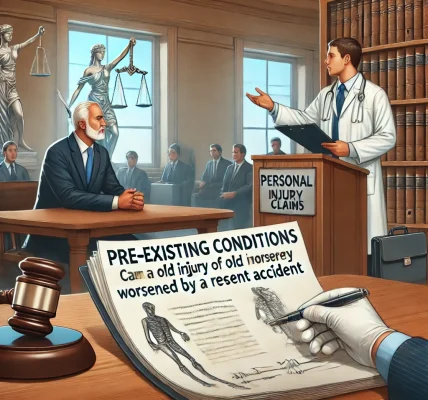When you file a personal injury claim, one of the most critical legal concepts that can impact your compensation is comparative fault. This principle determines how much compensation you can receive if you are found to be partially responsible for the accident. Understanding how comparative fault works and how it applies to personal injury cases can help you navigate the legal system and maximize your claim.
In this article, we will explore:
- What comparative fault means
- Different types of comparative fault rules
- How fault is determined
- The impact of comparative fault on compensation
- Ways to protect your claim if you share some fault
What Is Comparative Fault?
Comparative fault, also known as comparative negligence, is a legal principle used to determine liability when more than one party is responsible for an accident. Instead of placing full blame on one party, comparative fault assigns a percentage of responsibility to each party involved.
For example, if you were in a car accident and were found to be 20% at fault for not signaling before turning, while the other driver was 80% at fault for speeding, your compensation may be reduced by 20% based on your share of the fault.
Types of Comparative Fault Rules
Each state follows a different rule when it comes to comparative fault. The three main types of comparative fault laws are:
1. Pure Comparative Fault
In states that follow the pure comparative fault rule, you can recover compensation even if you are 99% at fault. However, your total compensation is reduced by your percentage of fault.
Example: If your damages total $100,000, but you are found to be 40% at fault, you would receive only $60,000 ($100,000 – 40%).
2. Modified Comparative Fault (50% Bar Rule)
Under this rule, you can only recover compensation if you are less than 50% at fault. If you are found 50% or more at fault, you cannot recover any compensation.
Example: If your damages are $100,000 and you are 49% at fault, you can recover $51,000 ($100,000 – 49%). But if you are 50% or more at fault, you receive nothing.
3. Modified Comparative Fault (51% Bar Rule)
This rule is similar to the 50% bar rule, but the threshold is 51% instead. If you are 51% or more at fault, you cannot recover any compensation.
Example: If your damages are $100,000 and you are 50% at fault, you can still recover $50,000. However, if you are 51% at fault, you receive nothing.
How Is Fault Determined in a Personal Injury Case?
Determining fault in a personal injury claim involves gathering and analyzing evidence to establish responsibility. The key factors include:
1. Police Reports
- Official reports from law enforcement provide an objective assessment of the accident.
- These reports may include witness statements, diagrams, and officer opinions on who was at fault.
2. Witness Statements
- Testimonies from people who saw the accident can support your claim.
- Witnesses provide unbiased accounts that can confirm your version of events.
3. Surveillance and Video Footage
- Traffic cameras, security cameras, and dashcams can provide concrete proof of how the accident happened.
- Clear video evidence can help dispute false claims.
4. Accident Reconstruction Experts
- Experts analyze the scene, vehicle damages, and other details to determine fault scientifically.
- Their reports can be used as strong evidence in court or negotiations.
5. Medical Records
- Medical reports show the extent of your injuries and whether they align with the accident circumstances.
- Any delays or inconsistencies in medical treatment can be used against you by the defense.
How Comparative Fault Affects Your Compensation
Your level of fault directly impacts the amount of compensation you can receive. Here’s how it works:
| Your Fault Percentage | Total Damages | Compensation You Receive |
|---|---|---|
| 0% (Not at fault) | $100,000 | $100,000 |
| 10% | $100,000 | $90,000 |
| 30% | $100,000 | $70,000 |
| 50% | $100,000 | $50,000 (Only in 51% bar rule states) |
| 51% or more | $100,000 | $0 (In modified comparative fault states) |
This reduction in compensation is why insurance companies often try to shift more blame onto the victim to reduce their payout.
Ways to Protect Your Claim If You Share Fault
If you believe you may be partially at fault for your accident, taking the following steps can protect your claim and ensure you still receive fair compensation:
1. Gather Strong Evidence
- Take pictures of the accident scene, injuries, and property damage.
- Obtain contact information from witnesses.
2. Avoid Admitting Fault
- Never admit fault at the scene, even if you think you contributed to the accident.
- Let the investigation determine responsibility.
3. Get a Copy of the Police Report
- Review the report for inaccuracies and dispute any errors.
- If the report unfairly assigns blame, your attorney can challenge it.
4. Consult a Personal Injury Lawyer
- A lawyer can negotiate with insurance companies to reduce your assigned fault percentage.
- Legal professionals understand state laws and can maximize your compensation.
5. Be Careful When Speaking to Insurance Adjusters
- Insurance companies often use your statements against you.
- Stick to the facts and avoid discussing fault.
Final Thoughts
Comparative fault plays a crucial role in personal injury claims. Whether your state follows pure comparative fault, modified comparative fault (50% rule), or modified comparative fault (51% rule), your compensation depends on your percentage of fault.
If you have been injured in an accident and believe you share some responsibility, consult a personal injury attorney to ensure you receive the compensation you deserve. Understanding how comparative fault works will help you protect your rights and avoid insurance company tactics designed to minimize your claim.
Don’t let shared fault prevent you from getting justice—seek legal help and fight for the compensation you deserve!




